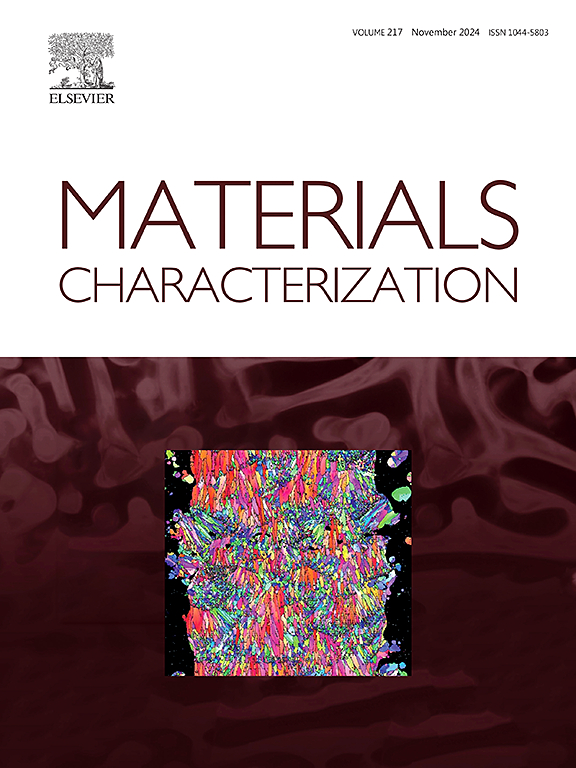Hf 合金对 Ni-Mn-Ga 高温形状记忆合金功能特性的影响
IF 4.8
2区 材料科学
Q1 MATERIALS SCIENCE, CHARACTERIZATION & TESTING
引用次数: 0
摘要
本文报告了多晶镍-锰-镓-铪高温形状记忆合金的功能特性和微观结构,其中在保持标称镍含量不变的情况下,加入了不同含量的铪(最高达 4%)以替代锰和镓。Hf 含量的增加促进了价电子浓度(e/a)、马氏体单元的四方性(c/a)和马氏体转变温度的降低,并显著减少了转变滞后。本文研究的所有合金都形成了非调制四方马氏体,这是典型的镍-锰-镓高温形状记忆合金,但含 4% Hf 的合金也含有一小部分调制 14M 马氏体。添加铪后,合金在高达 300 兆帕的压缩应力下的热机械响应得到改善,并且在含 3% 和 4% 铪的合金中,几乎实现了封闭循环,不可恢复应变最小,滞后(8 K)较低。这些合金在重复热循环下也表现出极佳的稳定性,在 870 K 下老化时几乎没有变化。当 Hf 含量为 1%时,富含 Hf 和 Ni 的第二相开始析出,随着 Hf 含量的增加,其体积分数突然逐渐增加。第二相的结构类似于其他镍锰镓基合金中常见的 f.c.c. γ 相,但它具有双晶格参数。针对这一新相,提出了两种基于空间群为 I4/mmm(编号 139)的 A6 面心四边形单胞(相当于双 f.c.c. 晶格)的结构模型。本文章由计算机程序翻译,如有差异,请以英文原文为准。
Impact of Hf alloying on the functional properties of Ni-Mn-Ga high temperature shape memory alloys
The paper reports on the functional properties and microstructure of polycrystalline Ni-Mn-Ga-Hf high temperature shape memory alloys, in which different amounts of Hf up to 4 at.% are added in substitution of Mn and Ga, while the nominal Ni content is kept constant. The increase in the amount of Hf promotes a decrease in the valence electron concentration (e/a), tetragonality (c/a) of the martensitic unit cell, and martensitic transformation temperatures, as well as a significant decrease of the transformation hysteresis. The non-modulated tetragonal martensite, typical of Ni-Mn-Ga high temperature shape memory alloys, is formed in all the alloys studied here, though the alloy with 4 at.% of Hf also contains a small fraction of modulated 14M martensite. Hf addition improves the thermomechanical response of the alloys under compressive stress up to 300 MPa and leads to nearly closed cycles with minimal irrecoverable strain and low hysteresis (8 K) for the alloys with 3 and 4 at.% of Hf. These alloys also demonstrate excellent stability under repetitive thermal cycling and little change upon aging at 870 K. A second phase rich in Hf and Ni starts to precipitate at 1 at.% of Hf addition and its volume fraction experiences an abrupt and progressive increase for higher Hf contents. The structure of the second phase looks like the usual f.c.c. γ phase reported in other Ni-Mn-Ga-based alloys, but it has a double lattice parameter. Two structural models based on the A6 face-centered tetragonal unit cell with space group I4/mmm (No. 139), equivalent to the double f.c.c. lattice, are proposed for this new phase.
求助全文
通过发布文献求助,成功后即可免费获取论文全文。
去求助
来源期刊

Materials Characterization
工程技术-材料科学:表征与测试
CiteScore
7.60
自引率
8.50%
发文量
746
审稿时长
36 days
期刊介绍:
Materials Characterization features original articles and state-of-the-art reviews on theoretical and practical aspects of the structure and behaviour of materials.
The Journal focuses on all characterization techniques, including all forms of microscopy (light, electron, acoustic, etc.,) and analysis (especially microanalysis and surface analytical techniques). Developments in both this wide range of techniques and their application to the quantification of the microstructure of materials are essential facets of the Journal.
The Journal provides the Materials Scientist/Engineer with up-to-date information on many types of materials with an underlying theme of explaining the behavior of materials using novel approaches. Materials covered by the journal include:
Metals & Alloys
Ceramics
Nanomaterials
Biomedical materials
Optical materials
Composites
Natural Materials.
 求助内容:
求助内容: 应助结果提醒方式:
应助结果提醒方式:


